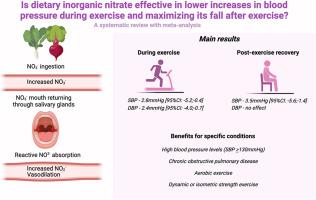当前位置:
X-MOL 学术
›
Free Radical Bio. Med.
›
论文详情
Our official English website, www.x-mol.net, welcomes your feedback! (Note: you will need to create a separate account there.)
Effects of dietary inorganic nitrate on blood pressure during and post-exercise recovery: A systematic review and meta-analysis of randomized placebo-controlled trials
Free Radical Biology and Medicine ( IF 7.4 ) Pub Date : 2024-02-23 , DOI: 10.1016/j.freeradbiomed.2024.02.011 Cicero Jonas R. Benjamim , Leonardo S. Lopes da Silva , Vitor E. Valenti , Leonardo S. Gonçalves , Andrey A. Porto , Márcio Fernando Tasinafo Júnior , Jean-Philippe Walhin , David M. Garner , Bruno Gualano , Carlos R. Bueno Júnior
Free Radical Biology and Medicine ( IF 7.4 ) Pub Date : 2024-02-23 , DOI: 10.1016/j.freeradbiomed.2024.02.011 Cicero Jonas R. Benjamim , Leonardo S. Lopes da Silva , Vitor E. Valenti , Leonardo S. Gonçalves , Andrey A. Porto , Márcio Fernando Tasinafo Júnior , Jean-Philippe Walhin , David M. Garner , Bruno Gualano , Carlos R. Bueno Júnior

|
A systematic review with meta-analysis was completed to study the effects of dietary inorganic nitrate (NO) oral ingestion from vegetables and salts on blood pressure responses during and following exercise. NO is a hypotensive agent with the potential to reduce blood pressure peaks during exercise and amplify exercise-induced hypotensive effects. Several randomized and controlled trials have investigated the effects of NO on hemodynamic responses to physical exercise, however this still has yet to be studied systematically. The searches were conducted on EMBASE, Medline, and SPORTSDiscus databases. The study included masked randomized controlled trials (RCTs) with participants ≥18 years old. The NOintervention group received at least 50 mg NO/day with similar sources amid NO and placebo conditions. Included studies reported systolic blood pressure (SBP) or diastolic blood pressure (DBP) values during or following exercise performance. 1903 studies were identified, and twenty-six achieved the inclusion criteria. NO daily dosages ranged from 90 to 800 mg/day. Throughout exercise, SBP had smaller increases in the NO group (−2.81 mmHg (95%CI: −5.20 to −0.41), p=0.02. DBP demonstrated lower values in the NO group (−2.41 mmHg (95%CI: −4.02 to −0.79), p=0.003. In the post-exercise group, the NO group presented lower SBP values (−3.53 mmHg (95%CI: −5.65 to 1.41), p=0.001, while no changes were identified in DBP values between NO and placebo groups (p=0.31). Subgroup meta-analysis revealed that SBP baseline values, exercise type, duration of NO ingestion, and its dosages mediated blood pressure responses during and following exercise. NO ingestion prior to exercise attenuated the increases in SBP and DBP during exercise, and increased the decline in SBP after exercise. These results are dependent on factors that moderate the blood pressure responses (e.g., health status, type of exercise, resting blood pressure values).
中文翻译:

膳食无机硝酸盐对运动恢复期间和运动后血压的影响:随机安慰剂对照试验的系统回顾和荟萃分析
一项荟萃分析系统综述旨在研究从蔬菜和盐中口服摄入无机硝酸盐 (NO) 对运动期间和运动后血压反应的影响。 NO 是一种降血压药,有可能降低运动期间的血压峰值并增强运动引起的降血压作用。几项随机对照试验已经研究了一氧化氮对体育锻炼血流动力学反应的影响,但这仍有待系统研究。检索是在 EMBASE、Medline 和 SPORTSDiscus 数据库上进行的。该研究包括受试者年龄≥18 岁的随机对照试验 (RCT)。 NO 干预组每天至少接受 50 mg NO,在 NO 和安慰剂条件下来源相似。纳入的研究报告了运动期间或运动后的收缩压 (SBP) 或舒张压 (DBP) 值。确定了 1903 项研究,其中 26 项达到了纳入标准。 NO 每日剂量范围为 90 至 800 毫克/天。在整个运动过程中,NO 组的收缩压 (SBP) 增加幅度较小 (-2.81 mmHg (95%CI: -5.20 至 -0.41),p=0.02。NO 组的舒张压 (DBP) 值较低 (-2.41 mmHg (95%CI: -4.02)至-0.79),p=0.003。在运动后组中,NO组表现出较低的SBP值(-3.53 mmHg(95%CI:-5.65至1.41),p=0.001,而DBP值没有变化NO 组和安慰剂组之间的差异(p=0.31)。亚组荟萃分析显示,SBP 基线值、运动类型、NO 摄入持续时间及其剂量介导运动期间和运动后的血压反应。运动前摄入 NO 减弱了血压的增加运动期间的收缩压和舒张压,以及运动后收缩压下降的增加。这些结果取决于调节血压反应的因素(例如健康状况、运动类型、静息血压值)。
更新日期:2024-02-23
中文翻译:

膳食无机硝酸盐对运动恢复期间和运动后血压的影响:随机安慰剂对照试验的系统回顾和荟萃分析
一项荟萃分析系统综述旨在研究从蔬菜和盐中口服摄入无机硝酸盐 (NO) 对运动期间和运动后血压反应的影响。 NO 是一种降血压药,有可能降低运动期间的血压峰值并增强运动引起的降血压作用。几项随机对照试验已经研究了一氧化氮对体育锻炼血流动力学反应的影响,但这仍有待系统研究。检索是在 EMBASE、Medline 和 SPORTSDiscus 数据库上进行的。该研究包括受试者年龄≥18 岁的随机对照试验 (RCT)。 NO 干预组每天至少接受 50 mg NO,在 NO 和安慰剂条件下来源相似。纳入的研究报告了运动期间或运动后的收缩压 (SBP) 或舒张压 (DBP) 值。确定了 1903 项研究,其中 26 项达到了纳入标准。 NO 每日剂量范围为 90 至 800 毫克/天。在整个运动过程中,NO 组的收缩压 (SBP) 增加幅度较小 (-2.81 mmHg (95%CI: -5.20 至 -0.41),p=0.02。NO 组的舒张压 (DBP) 值较低 (-2.41 mmHg (95%CI: -4.02)至-0.79),p=0.003。在运动后组中,NO组表现出较低的SBP值(-3.53 mmHg(95%CI:-5.65至1.41),p=0.001,而DBP值没有变化NO 组和安慰剂组之间的差异(p=0.31)。亚组荟萃分析显示,SBP 基线值、运动类型、NO 摄入持续时间及其剂量介导运动期间和运动后的血压反应。运动前摄入 NO 减弱了血压的增加运动期间的收缩压和舒张压,以及运动后收缩压下降的增加。这些结果取决于调节血压反应的因素(例如健康状况、运动类型、静息血压值)。



























 京公网安备 11010802027423号
京公网安备 11010802027423号